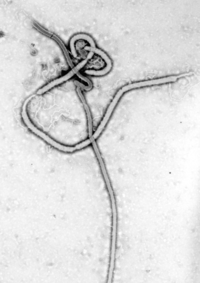
Photo from wikipedia
Significance This paper describes findings from a seroepidemiologic study involving a cohort of Ebola-vaccinated individuals from North Kivu, Democratic Republic of the Congo (DRC), who were studied as part of… Click to show full abstract
Significance This paper describes findings from a seroepidemiologic study involving a cohort of Ebola-vaccinated individuals from North Kivu, Democratic Republic of the Congo (DRC), who were studied as part of a collaborative effort between American and Congolese scientists and epidemiologists. Our study examines antibody response at 21 d and 6 mo postvaccination after single-dose rVSVΔG-ZEBOV-GP vaccination among Ebola virus disease–exposed and potentially exposed populations in the DRC. At 21 d of follow-up, 87.2% had an antibody response. Additionally, 95.6% demonstrated antibody persistence at 6 mo of follow-up. These findings give crucial evidence that antibody response and persistence after Ebola vaccination is robust in outbreak settings in the DRC, knowledge that significantly informs the use of vaccination for outbreak control. Despite more than 300,000 rVSVΔG-ZEBOV-glycoprotein (GP) vaccine doses having been administered during Ebola virus disease (EVD) outbreaks in the Democratic Republic of the Congo (DRC) between 2018 and 2020, seroepidemiologic studies of vaccinated Congolese populations are lacking. This study examines the antibody response at 21 d and 6 mo postvaccination after single-dose rVSVΔG-ZEBOV-GP vaccination among EVD-exposed and potentially exposed populations in the DRC. We conducted a longitudinal cohort study of 608 rVSVΔG-ZEBOV-GP–vaccinated individuals during an EVD outbreak in North Kivu Province, DRC. Participants provided questionnaires and blood samples at three study visits (day 0, visit 1; day 21, visit 2; and month 6, visit 3). Anti-GP immunoglobulin G (IgG) antibody titers were measured in serum by the Filovirus Animal Nonclinical Group anti-Ebola virus GP IgG enzyme-linked immunosorbent assay. Antibody response was defined as an antibody titer that had increased fourfold from visit 1 to visit 2 and was above four times the lower limit of quantification at visit 2; antibody persistence was defined as a similar increase from visit 1 to visit 3. We then examined demographics for associations with follow-up antibody titers using generalized linear mixed models. A majority of the sample, 87.2%, had an antibody response at visit 2, and 95.6% demonstrated antibody persistence at visit 3. Being female and of young age was predictive of a higher antibody titer postvaccination. Antibody response and persistence after Ebola vaccination was robust in this cohort, confirming findings from outside of the DRC.
Journal Title: Proceedings of the National Academy of Sciences of the United States of America
Year Published: 2022
Link to full text (if available)
Share on Social Media: Sign Up to like & get
recommendations!